MULTIPLYING BINOMIALS
Subscribe to our ▶️ YouTube channel 🔴 for the latest videos, updates, and tips.
To multiply binomials which are in the form of
(x+a) (x+b)
we will follow the steps given below.
- Multiply x by (x+b).
- Multiply a by (x+b)
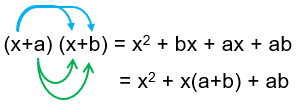
Expand the following and simplify :
Problem 1 :
(x + 2) (x + 5)
Solution :
By distributing x and 2, we get
= (x ∙ x) + (x ∙ 5) + (2 ∙ x) + (2 ∙ 5)
= x2 + 5x + 2x + 10
By combining like terms.
= x2+7x+10
Problem 2 :
(x - 3) (x + 4)
Solution :
By distributing x and -3, we get
= (x ∙ x) + (x ∙ 4) + (-3 ∙ x) + ( -3 ∙ 4)
= x2 + 4x - 3x - 12
By combining like terms.
= x2 + x - 12
Problem 3 :
(x - 2) (x - 10)
Solution :
By distributing x and -2, we get
= (x ∙ x) - 10 (x) + (-2)x + (-2) (-10)
= x2 -10x - 2x + 20
By combining like terms.
= x2 - 12x + 20
Problem 4 :
(2x + 1) (x - 3)
Solution :
By distributing 2x and 1, we get
= (2x ∙ x) + 2x (-3) + 1x + 1(-3)
= 2x2 - 6x + x - 3
By combining like terms.
= 2x2 - 5x - 3
Problem 5 :
(2x + y) (x - y)
Solution :
By distributing 2x and y, we get
= (2x ∙ x) + (2x)(-y) + (y ∙ x) + (y) (-y)
= 2x2 - 2xy + xy - y2
By combining like terms.
= 2x2 - xy - y2
Problem 6 :
(x + 3) (-2x - 1)
Solution :
By distributing x and 3, we get
= x(-2x) + x (-1) + 3 (-2x) + (3) (-1)
= -2x2 - x - 6x - 3
By combining like terms.
= -2x2 - 7x - 3
Multiplying Binomials to Get Difference of Two Squares
Expand and simplify :
Problem 7 :
(x + 7) (x - 7)
Solution :
By distributing x and 7, we get
= (x ∙ x) + x ( -7) + (7 ∙ x) + 7 (-7)
= x2 -7x + 7x - 49
By combining like terms.
= x2 - 49
By observing the binomial given above, they are almost same except the signs. Instead of multiplying the binomials directly, we can use algebraic identity
(a + b) (a - b) = a2 - b2
(x + 7) (x - 7) = x2 - 72
= x2 - 49
Problem 8 :
(3 + a)(3 - a)
Solution :
By distributing 3 and a, we get
= (3 ∙ 3) + 3(-a) + a(3) + a(-a)
= 9 - 3a + 3a - a2
By combining like terms.
= 9 - a2
Alternative Method :
(a + b) (a - b) = a2 - b2
(3 + a) (3 - a) = 32 - a2
= 9 - a2
Problem 9 :
(2x + 1) (2x - 1)
Solution :
By distributing 2x and 1, we get
= (2x) (2x) + (2x) (-1) + 1 (2x) + 1 (-1)
= 4x2 - 2x + 2x - 1
By combining like terms.
= 4x2-1
Alternative Method :
(a + b) (a - b) = a2 - b2
(2x + 1) (2x - 1) = (2x)2 - 12
= 4x2 - 1
Problem 10 :
(4 - 3y) (4 + 3y)
Solution :
By distributing 4 and -3y, we get
= (4 ∙ 4) + (4 ∙ 3y) + 4(-3y) + (-3y) (3y)
= 16 + 12y - 12y - 9y2
By combining like terms.
= 16 - 9y2
Problem 11 :
5(3x + c) = 15x + 40
Solution :
5(3x + c) = 15x + 40
Using distributive property, we get
15x + 5c = 15x + 40
By equating the corresponding terms, we get
5c = 40
c = 40/5
c = 8
So, the value of c is 8.
Problem 12 :
Write a polynomial that represents the area of the shaded region.
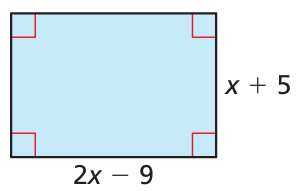
Solution :
Length = 2x - 9 and width = x + 5
Area of rectangle = length ⋅ width
= (2x - 9)(x + 5)
= 2x(x) + 2x(5) - 9(x) - 9(5)
= 2x2 + 10x - 9x - 45
= 2x2 + x - 45
Problem 13 :
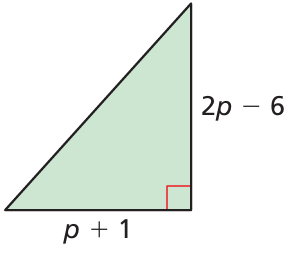
Solution :
Base = p + 1 and height = 2p - 6
Area of triangle = (1/2) ⋅ base ⋅ height
= (1/2) (p + 1)(2p - 6)
= (1/2) (2p2 - 6p + 2p - 6)
= (1/2) (2p2 - 4p - 6)
= (2p2 - 4p - 6)/2
= p2 - 2p - 3
So, area of triangle is p2 - 2p - 3.
Problem 14 :
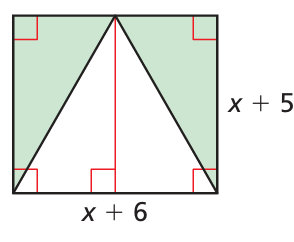
Solution :
By observing the figrue, we have triangle inscribed inside the rectangle.
Dimensions of rectangle :
Length = x + 6 and width = x + 5
Dimensions of triangle :
Base = x + 6 and height = x + 5
Area of shaded region = Area of rectangle - area of traingle
= (x + 6)(x + 5) - (1/2)(x + 6)(x + 5)
= (1/2)(x + 6)(x + 5)
= (1/2)(x2 + 5x + 6x + 30)
= (1/2)(x2 + 11x + 30)
Problem 15 :
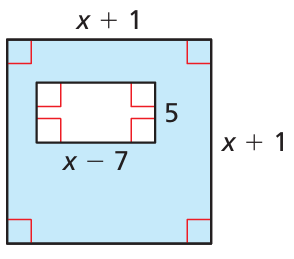
Solution :
By observing the figrue, we have rectangle inscribed in a square.
Dimensions of rectangle :
Length = x - 7 and width = 5
Dimensions of sqaure :
Side length = x + 1
Area of shaded region = Area of sqaure - area of rectangle
= (x + 1)(x + 1) - (x - 7) 5
= x2 + 1x + 1x + 1 - 5x + 35
= x2 + 2x - 5x + 35 + 1
= x2 - 3x + 36
Subscribe to our ▶️ YouTube channel 🔴 for the latest videos, updates, and tips.
Recent Articles
-
Finding Range of Values Inequality Problems
May 21, 24 08:51 PM
Finding Range of Values Inequality Problems -
Solving Two Step Inequality Word Problems
May 21, 24 08:51 AM
Solving Two Step Inequality Word Problems -
Exponential Function Context and Data Modeling
May 20, 24 10:45 PM
Exponential Function Context and Data Modeling